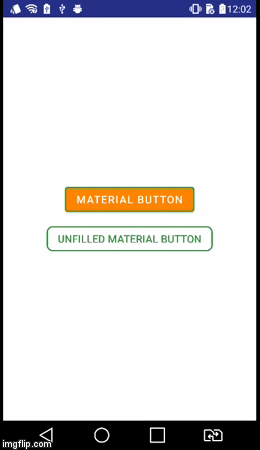Android-按钮边框
Answers:
步骤1:创建名为:my_button_bg.xml的文件
步骤2:将此文件放置在res / drawables.xml中
步骤3:插入以下代码
<?xml version="1.0" encoding="utf-8"?>
<shape xmlns:android="http://schemas.android.com/apk/res/android"
android:shape="rectangle">
<gradient android:startColor="#FFFFFF"
android:endColor="#00FF00"
android:angle="270" />
<corners android:radius="3dp" />
<stroke android:width="5px" android:color="#000000" />
</shape>
步骤4:在需要的地方使用代码“ android:background =“ @ drawable / my_button_bg”,例如:
<Button
android:layout_width="wrap_content"
android:layout_height="wrap_content"
android:text="Your Text"
android:background="@drawable/my_button_bg"
/>
• Android Official Solution
自从引入Android Design支持v28以来,使用即可轻松创建带边框的按钮MaterialButton。此类为构造函数中的按钮提供更新的Material样式。使用app:strokeColor和app:strokeWidth您可以创建自定义边框,如下所示:
1.使用时androidx:
build.gradle
dependencies {
implementation 'androidx.appcompat:appcompat:1.1.0'
implementation 'com.google.android.material:material:1.0.0'
}
•带边框的按钮:
<com.google.android.material.button.MaterialButton
style="@style/Widget.AppCompat.Button.Colored"
android:layout_width="wrap_content"
android:layout_height="wrap_content"
android:text="MATERIAL BUTTON"
android:textSize="15sp"
app:strokeColor="@color/green"
app:strokeWidth="2dp" />
•未填充边框按钮:
<com.google.android.material.button.MaterialButton
style="@style/Widget.AppCompat.Button.Borderless"
android:layout_width="wrap_content"
android:layout_height="wrap_content"
android:text="UNFILLED MATERIAL BUTTON"
android:textColor="@color/green"
android:textSize="15sp"
app:backgroundTint="@android:color/transparent"
app:cornerRadius="8dp"
app:rippleColor="#33AAAAAA"
app:strokeColor="@color/green"
app:strokeWidth="2dp" />
2.使用时appcompat:
build.gradle
dependencies {
implementation 'com.android.support:design:28.0.0'
}
style.xml
确保您的应用程序主题继承自Theme.MaterialComponents而不是Theme.AppCompat。
<style name="AppTheme" parent="Theme.MaterialComponents.Light.DarkActionBar">
<!-- Customize your theme here. -->
</style>
•带边框的按钮:
<android.support.design.button.MaterialButton
android:layout_width="wrap_content"
android:layout_height="wrap_content"
android:text="MATERIAL BUTTON"
android:textSize="15sp"
app:strokeColor="@color/green"
app:strokeWidth="2dp" />
•未填充边框按钮:
<android.support.design.button.MaterialButton
style="@style/Widget.AppCompat.Button.Borderless"
android:layout_width="wrap_content"
android:layout_height="wrap_content"
android:text="UNFILLED MATERIAL BUTTON"
android:textColor="@color/green"
android:textSize="15sp"
app:backgroundTint="@android:color/transparent"
app:cornerRadius="8dp"
app:rippleColor="#33AAAAAA"
app:strokeColor="@color/green"
app:strokeWidth="2dp" />
视觉结果
style="@style/Widget.AppCompat.Button.Borderless"怎么办?
button_border.xml在您的可绘制文件夹中创建文件。
res / drawable / button_border.xml
<?xml version="1.0" encoding="utf-8"?>
<shape xmlns:android="http://schemas.android.com/apk/res/android"
android:shape="rectangle" >
<solid android:color="#FFDA8200" />
<stroke
android:width="3dp"
android:color="#FFFF4917" />
</shape>
并将按钮添加到XML活动布局并设置background android:background="@drawable/button_border"。
<Button
android:layout_width="wrap_content"
android:layout_height="wrap_content"
android:background="@drawable/button_border"
android:text="Button Border" />
创建drawable / button_green.xml:
<?xml version="1.0" encoding="utf-8"?>
<shape xmlns:android="http://schemas.android.com/apk/res/android"
android:shape="rectangle">
<gradient
android:startColor="#003000"
android:centerColor="#006000"
android:endColor="#003000"
android:angle="270" />
<corners android:radius="5dp" />
<stroke android:width="2px" android:color="#007000" />
</shape>
并指出为@drawable/button_green:
<Button
android:id="@+id/button1"
android:layout_width="wrap_content"
android:layout_height="wrap_content"
android:layout_margin="10dp"
android:background="@drawable/button_green"
android:text="Button" />
请在此处查看有关创建形状可绘制对象的信息 http://developer.android.com/guide/topics/resources/drawable-resource.html#Shape
完成此操作后,在XML中为您的按钮设置 android:background="@drawable/your_button_border"
如果按钮不需要透明的背景,则可以使用“框架布局”创建边框的错觉。只需调整FrameLayout的“ padding”属性即可更改边框的粗细。
<FrameLayout
android:layout_width="wrap_content"
android:layout_height="wrap_content"
android:padding="1sp"
android:background="#000000">
<Button
android:layout_width="wrap_content"
android:layout_height="wrap_content"
android:text="Your text goes here"
android:background="@color/white"
android:textColor="@color/black"
android:padding="10sp"
/>
</FrameLayout>
我不确定shape xml文件是否具有可动态编辑的边框颜色。但是我确实知道,使用此解决方案,您可以通过设置FrameLayout背景来动态更改边框的颜色。
在您的XML布局中:
<Button
android:id="@+id/cancelskill"
android:layout_width="0dp"
android:layout_height="wrap_content"
android:layout_marginLeft="25dp"
android:layout_weight="1"
android:background="@drawable/button_border"
android:padding="10dp"
android:text="Cancel"
android:textAllCaps="false"
android:textColor="#ffffff"
android:textSize="20dp" />
在drawable文件夹中,为按钮的边框样式创建一个文件:
<shape xmlns:android="http://schemas.android.com/apk/res/android"
android:shape="rectangle" >
<stroke
android:width="1dp"
android:color="#f43f10" />
</shape>
在您的活动中:
GradientDrawable gd1 = new GradientDrawable();
gd1.setColor(0xFFF43F10); // Changes this drawbale to use a single color instead of a gradient
gd1.setCornerRadius(5);
gd1.setStroke(1, 0xFFF43F10);
cancelskill.setBackgroundDrawable(gd1);
cancelskill.setOnClickListener(new View.OnClickListener() {
@Override
public void onClick(View v) {
cancelskill.setBackgroundColor(Color.parseColor("#ffffff"));
cancelskill.setTextColor(Color.parseColor("#f43f10"));
GradientDrawable gd = new GradientDrawable();
gd.setColor(0xFFFFFFFF); // Changes this drawbale to use a single color instead of a gradient
gd.setCornerRadius(5);
gd.setStroke(1, 0xFFF43F10);
cancelskill.setBackgroundDrawable(gd);
finish();
}
});
我知道它大概晚了一年,但你也可以创建一个9路图像有自带的Android SDK,这有助于创造这样的图片查看这个链接的工具:http://developer.android.com/tools/help/draw9patch .html
PS:图像也可以无限缩放
